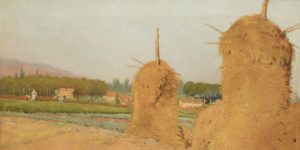2 results
Biografia
Meifrén started medical studies but quickly abandoned them, discovering his true vocation for drawing and painting. This decision led him to enter the School of Fine Arts in Barcelona, where he had as teachers renowned artists such as the portrait artist Antoni Caba (1838–1907) or the landscape artist Ramon Martí Alsina (1826–1894). He moved to Paris, where he lived for several years, attracted to the French Impressionists. In 1889 he won a medal at the Paris Universal Exhibition. He returns to Barcelona, but travels constantly through Catalonia, Spain and several times abroad: Italy, England, South America and the United States where he resides in New York for a longer period in 1915.
Multiple exhibitions followed, achieving, among other rewards: gold medal at the Regional Exhibition of Valencia (1879); first-class medal in the Fine Arts of Barcelona (1896); first medallion in the National of Madrid (1906); silver medal in Brussels University and Grand Prix at the University of Buenos Aires (1910); and the Grand Prix in the International of San Francisco (1915); he is a founding partner of the Centre of Aquarelists of Barcelona in 1884; he is also a member of the jury of rewards in several expositions and has for some time served as Director of the School of Fine arts of Palma de Mallorca. He is related to the First Group of Sitges and later to the promoters of modernism. Eliseo Meifren, around 1891, speaks of Sitges and accompanies Rusiñol there. He attends with them the talks of “Els quatre gats” and participates in several modernist demonstrations, although he never fully identified with this group.
Eliseo Meifrèn was a very fruitful painter and most of his pictorial production was focused on treating the landscape outdoors. His work can be differentiated in three evolutionary stages, the first, of formation that encompasses the years he was in Lonja until he marched to Paris, characterized by a thorough drawing and by the detail of the brush. In his second stage he is characterized by a progressive interest in capturing the luminosity and the right atmosphere in the picture, identifying with the first group of Sitges, although its relationship with Más and Fondevila and Roig Soler is passing, the brush is more spontaneous.
The final stage, of maturity, is characterized by successive journeys, expanding the color range and by a total mastery of the technique and treatment of color. Bohemian and provocative, Meifrén is a clear example of the nomadic artist, constantly looking for new landscapes in which to study light, color and free impression. His lifelong journey is filled with trips across the globe, in which he received awards and recognitions, arising as one of the main Spanish painters of his time. The work of Eliseo Meifrèn acquires a special interest by studying his case within the context of landscape design in Catalonia as it represents the passage from luminism, developed by the painters of the first group of Sitges, to impressionism.



